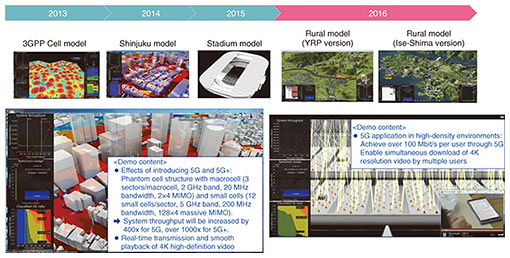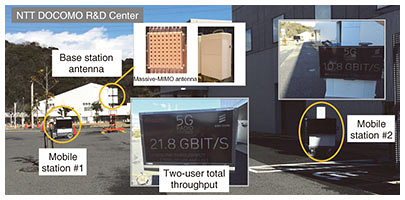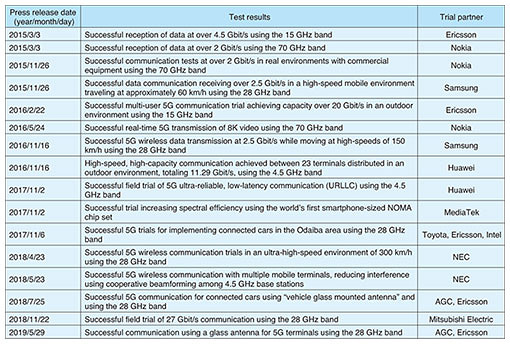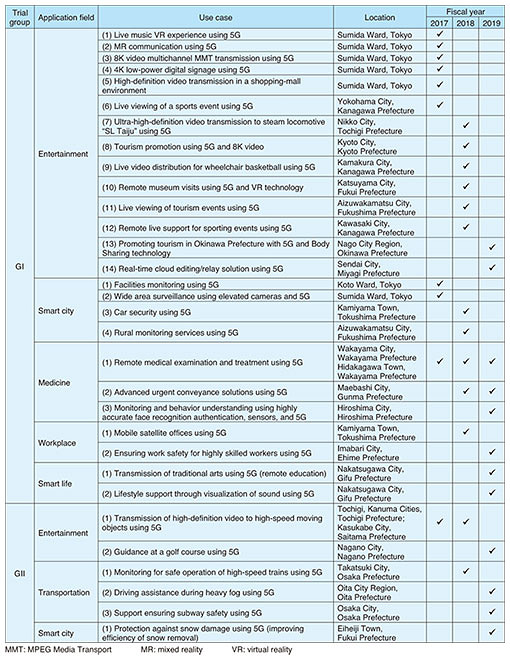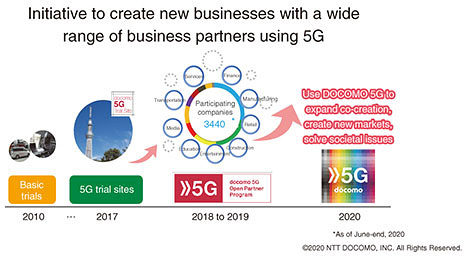 |
|||||||||||||||||||||||||||||||||||||||||||||||||||
|
|
|||||||||||||||||||||||||||||||||||||||||||||||||||
|
Feature Articles: NTT DOCOMO 5G Initiatives for Solving Social Problems and Achieving Social Transformation Vol. 18, No. 12, pp. 71–77, Dec. 2020. https://doi.org/10.53829/ntr202012fa11 History of 5G InitiativesAbstractIn March 2020, NTT DOCOMO began providing commercial fifth-generation mobile communications systems (5G) services, which we have been studying since about 2010. Since then, we have steadily released products supporting 5G, including six smartphone models and one data communications device (a Wi-Fi router), and have introduced seven services utilizing the high speed and high capacity of 5G, such as “Shintaikan Live CONNECT,” which enables multi-angle (multi-viewpoint) and virtual-reality live viewing. Keywords: 5G concepts, 5G trials, 5G use cases 1. IntroductionIn 2010, when NTT DOCOMO began its Long Term Evolution (LTE) services, we started investigating fifth-generation mobile communications systems (5G) with the goal of implementing them within ten years. We studied the basic concepts and radio access technologies for 5G, prototyped 5G simulators, and in 2014, we published a 5G white paper [1]. That same year, we also began 5G trials in collaboration with individual hardware vendors from around the world, and evaluation of 5G frequencies and radio access technologies. We also expanded collaboration in 5G trials with various partner enterprises around the world and developed many use cases for features of 5G through joint trials with these partners. In February 2018, we started the NTT DOCOMO 5G Open Partner Program to promote co-creation of solutions with partner organizations. This article reviews these initiatives at NTT DOCOMO, from proposing basic 5G concepts to co-creation of solutions through trial activities. 2. Preparing for publication of the 5G white paper (2010 to 2014)In about 2010, looking forward to 2020, mobile communication traffic was expected to increase rapidly, by a factor of 1000 in ten years, so to meet such requirements, we proposed a “cube” concept (improve spectral efficiency*1 × expand frequency bandwidth × increase network density) as a direction for technical advancement [2]. In around 2011, we proposed specific technical candidates for implementing this cube concept, such as a radio access technology combining the existing low-frequency bands with high-frequency bands of 6 GHz or greater [3]. Then, around 2012, requirements that are now features of 5G in addition to high speed and capacity came to light, including low latency and many-terminal connectivity, and the current definition of 5G combining extensions to LTE and a new radio access technology (New RAT)*2 was proposed [4]. By about 2013, the technical concepts described in the 5G white paper published in 2014 were largely complete, including services and applications anticipated for the 5G era [5]. In this way, the basic concepts and radio access technologies for 5G advanced, building consensus with major companies around the world, and also including proposals from other companies that shared requirements and other concepts, such as exploiting higher frequency bands [6, 7]. Initially, NTT DOCOMO used the name “future radio access” externally, but the name “5G” was first used in October 2013 at CEATEC. At this first exhibit of 5G, a demonstration was given using a simulator to visualize the basic 5G concepts and radio access technologies, which received the Minister for Internal Affairs and Communications CEATEC Award 2013 [8]. As shown in Fig. 1, development of the 5G simulator continued after that, with updates such as the stadium model. Around the time when the “5G” was first used, the focus for the 5G radio access technology was on using high-frequency bands efficiently, with massive multiple-input multiple-output (Massive MIMO)*3, in 5G research projects such as Mobile and wireless communications Enablers for the Twenty-twenty Information Society (METIS)*4 in Europe. NTT DOCOMO participated in METIS, leading proposals for technologies such as Phantom cells*5 (C/U (control and user plane) separation) [9] and non-orthogonal multiple access (NOMA)*6 [10]. These radio technologies and simulator prototyping were also published in the “DOCOMO 5G White Paper,” as the latest work at the time [1].
3. 5G trials and development of use cases (2014 to 2020)3.1 NTT DOCOMO initiatives with partner enterprisesTo verify 5G frequencies and key radio access technologies, NTT DOCOMO conducted 5G trials collaborating individually with major global vendors. In May 2014, we announced joint testing with six companies [11], and in July 2015, we expanded this to 13 companies [12]. Through joint testing with each of these companies, we verified 5G radio access technologies such as Massive MIMO in frequency bands up to the 70 GHz band, and in February 2016, we successfully conducted the world’s first multi-user 5G communication tests, achieving total throughput exceeding 20 Gbit/s in an outdoor environment (Fig. 2). Results of other major 5G radio technology trials published in press releases are shown in Table 1. By March 2018, we had given 170 conference presentations based on these 5G trials [13].
Starting around 2016, we have developed various use cases utilizing features of 5G in collaboration with partner enterprises in various industries [14]. To date, we have conducted 430 service trials (as of June 2020), such as building 5G trial sites as 5G test environments in the Tokyo Rinkai Fukutoshin district (Odaiba/Aomi areas) and the Tokyo Skytree Town neighborhood. 3.2 MIC 5G field trial initiatives (2017 to 2019)Over three years starting in FY2017, the Ministry of Internal Affairs and Communications (MIC) has conducted the 5G Field Trials, toward creation of new markets and new services and applications, with participants from various application fields [15]. The content of 5G field trials conducted by NTT DOCOMO throughout Japan with collaboration partners over the three years is shown in Table 2. Trial group GI conducted field trials in low-speed mobile environments, while trial group GII conducted field trials in high-speed mobile environments (60 km/h and greater). In 5G field trials in FY2017, GI conducted trials of 10 Gbit/s ultrahigh-speed communication in densely populated areas and service and application trials using 4.5-GHz and 28-GHz bands in the application fields of entertainment, smart city, and medicine [16]. NTT DOCOMO also participated in 2-Gbit/s high-speed communication trials while moving at high speed (GII), which were conducted mainly by NTT Communications, with entertainment field trials communicating using the 28-GHz band while traveling at the high speed of 90 km/h [16].
In 5G field trials in FY2018, we conducted trials at ultrahigh-speeds (GI) averaging 4 to 8 Gbit/s in an outdoor environment to verify both maximum and average 5G performance, and in office/workplace environments in addition to the three application fields tested in FY2017 [17]. We also conducted trials of high-speed communication averaging 1 Gbit/s for fast-moving objects traveling at 60 to 120 km/h (GII), and in the field of transportation in addition to entertainment [17]. In January 2019, MIC held the 5G Utilization Ideas Contest, with the objective of uncovering unique ideas that can resolve various issues that arise in outlying areas [18]. 5G field trials in FY2019 emphasized user models that use 5G to solve regional issues or contribute to regional revitalization, encompassing results from the idea contest described above, and from earlier technology trials. This involved trials with various new collaboration partners in various application fields [19]. 4. Creating solutions with partnersTo expand initiatives for creating new user scenarios with a wide range of partners, NTT DOCOMO started the DOCOMO 5G Open Partner Program in February 2018 (Fig. 3). This program provided information regarding 5G technologies and specifications to partner enterprises and organizations, and 5G Partner Workshops as a place for them to exchange ideas with each other. As of the end of June 2020, there were 3440 partners participating.
NTT DOCOMO also operates the DOCOMO 5G Open Lab as a permanent 5G technology test bed, providing partners with test equipment free of charge, such as 5G test base stations and video transmitters connected to mobile test stations. By participating in this program, partner enterprises and organizations can build and test services using 5G early, before commercial services begin, improving the quality of their own services and creating new services using the features of 5G, which are high speed, high capacity, low latency, and multi-terminal connectivity. As of the end of June 2020, DOCOMO 5G Open Lab had 11 locations in Japan and internationally. DOCOMO 5G Open Lab is also providing the DOCOMO Open Innovation Cloud trial environment connected directly to cloud computing infrastructure and is conducting technology verification. NTT DOCOMO also began the 5G pre-commercial service in September 2019. It uses the same network equipment and frequency bands as 5G commercial services, and represents the start of services substantially the same as connecting to a 5G commercial service, enabling business creation to begin in earnest, and allowing users to experience an environment equivalent to a 5G commercial service. The 5G pre-commercial service is for the over-3000 partners participating in the DOCOMO 5G Open Partner Program, and by lending out terminals that support the 5G pre-commercial service together with provision of 5G Open Lab, over 200 of field trials have been conducted throughout Japan, toward creating industries using 5G and solving social issues. From these, seven services and 22 solutions produced through co-creation with all of our partners, such as Shintaikan Live CONNECT, were announced at the start of 5G services, focused on solving social issues such as advancing industry and reform work practices. In the future, we intend to provide new kinds of value related to work practices, utilizing the 5G features of high speed, high capacity, and low latency, and focusing on areas such as remote work support and high-definition video transmission. 5. ConclusionIn this article, we described the path leading to the start of 5G services by NTT DOCOMO. In the future, NTT DOCOMO will continue to study technologies and conduct research and development, with the goal of further advancing 5G. This article is the reproduction of the special article published in NTT DOCOMO Technical Journal (Vol. 22, No. 2, Oct. 2020). References
Trademark notesAll company names or names of products, software, and services appearing in this article are trademarks or registered trademarks of their respective owners. |
|||||||||||||||||||||||||||||||||||||||||||||||||||









